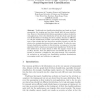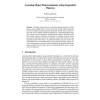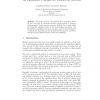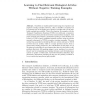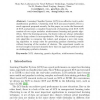104
click to vote
AUSAI
2008
Springer
15 years 2 months ago
2008
Springer
Traditional text classification algorithms are based on a basic assumption: the training and test data should hold the same distribution. However, this identical distribution assum...
104
click to vote
AUSAI
2008
Springer
15 years 2 months ago
2008
Springer
In this paper the notion of a partial-order plan is extended to task-hierarchies. We introduce the concept of a partial-order taskhierarchy that decomposes a problem using multi-ta...
132
click to vote
AUSAI
2008
Springer
15 years 2 months ago
2008
Springer
Planning collision-free paths for multiple robots traversing a shared space is a problem that grows combinatorially with the number of robots. The naive centralised approach soon ...
123
click to vote
AUSAI
2008
Springer
15 years 2 months ago
2008
Springer
In recent years, there has been a cross-fertilization of ideas between computational neuroscience models of the operation of the neocortex and artificial intelligence models of mac...
AUSAI
2008
Springer
15 years 2 months ago
2008
Springer
Data anonymization techniques based on enhanced privacy principles have been the focus of intense research in the last few years. All existing methods achieving privacy principles ...
100
Voted
AUSAI
2008
Springer
15 years 2 months ago
2008
Springer
This paper explores the use of alternating sequential patterns of local features and saccading actions to learn robust and compact object representations. The temporal encoding rep...
124
click to vote
AUSAI
2008
Springer
15 years 2 months ago
2008
Springer
Abstract. This paper presents a formulation of an optimality principle for a new class of concurrent decision systems formed by products of deterministic Markov decision processes ...
117
click to vote
AUSAI
2008
Springer
15 years 2 months ago
2008
Springer
When a user is looking for a product recommendation they usually lack expert knowledge regarding the items they are looking for. Ontologies on the other hand are crafted by experts...
121
click to vote
AUSAI
2008
Springer
15 years 2 months ago
2008
Springer
Classifiers are traditionally learned using sets of positive and negative training examples. However, often a classifier is required, but for training only an incomplete set of pos...
AUSAI
2008
Springer
15 years 2 months ago
2008
Springer
Learning Classifier System (LCS) is an effective tool to solve classification problems. Clustering with XCS (accuracy-based LCS) is a novel approach proposed recently. In this pape...
